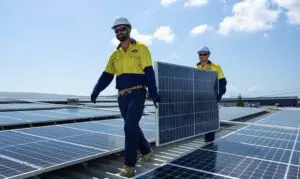Australian oil and gas giant Woodside has firmed up its giga-scale plans for the production and export of green hydrogen and ammonia from Tasmania to Japan, after securing land for the proposed H2Tas plant.
Woodside said late Friday that it had agreed to terms for the long-term lease of an industrial site in the Austrak Business Park, in the Bell Bay area of northern Tasmania, where it would begin phased development of the renewable hydrogen project.
H2Tas will tap Tasmania’s abundance of hydropower and the increasing supply of wind power to create a 100% renewable ammonia product for export, and renewable hydrogen for domestic use, starting with an initial capacity of up to 300MW.
This first phase would target production of 200,000 tonnes per annum of ammonia, matched to forecast export demand, and small volumes of hydrogen and ammonia for use locally as the domestic market starts to take off.
At full capacity, Woodside says the plant will comprise a 1.7GW phased electrolysis-based hydrogen and ammonia plant, subject to customer demand and utility availability.
The selection of a site for H2Tas follows the completion of feasibility studies with project partners Marubeni Corporation and IHI Corporation that found it would be technically and commercially feasible to export ammonia to Japan from the Bell Bay area.
The project has the backing of the Tasmanian government, with the two parties signing an MOU to cooperate on the development of hydrogen industries on the island state.
Woodside has also secured a non-binding commitment from Tasmanian gas supplier Tas Gas to develop processes for the blending of hydrogen with natural gas in the state’s main gas network.
In comments in January, former Woodside CEO Peter Coleman said the company was focused on moving beyond feasibility studies and was targeting hydrogen production at H2Tas in the first half of 2023.
This week, however, the company said it was targeting a final investment decision in 2023, with construction and commissioning expected to take approximately 24 months.
Woodside CEO Meg O’Neill said in a statement the project is garnering interest from existing and prospective Woodside customers in Asia and Europe.
“Importantly, this project would also create local construction and operational jobs and new opportunities for Tasmanian businesses.”
Woodside’s pivot to hydrogen production – not all of it green, however – is part of a huge global shift in focus to the potentially zero emissions fuel, as the key to the decarbonisation of sectors including heavy industry, shipping, and air transport.
Leading this charge in Australia has been iron ore billionaire Andrew Forrest, whose renewables-focused side venture Fortescue Future Industries has been churning out billions of dollars worth of green hydrogen production plans, covering all links of the supply chain.
Unlike FFI, which Forrest has promised will not mangle the hydrogen production process by using anything other than 100% renewable energy, Woodside’s plans come in a number of different shades.
H2Perth, for example, which Woodside says will be one of the largest facilities of its kind in the world, producing up to 1500 tonnes a day of hydrogen for export in the form of ammonia and liquid hydrogen.
However, it will use both electrolysis technologies and natural gas reforming – the latter initially requiring 40 terajoules per day of natural gas.
No detail was given on the power source for the H2Perth facility’s electrolysers in the project’s first stages, but a company spokesperson said at the time that there was “scope” for renewable energy to be phased into the project as it grew in size.
Until then, that means that output from the facility will not be green – at least in the project’s first phase. At best, the hydrogen produced via steam methane reformation could be classed as blue, and would be far from emissions-free, even factoring in the use of CCS.








